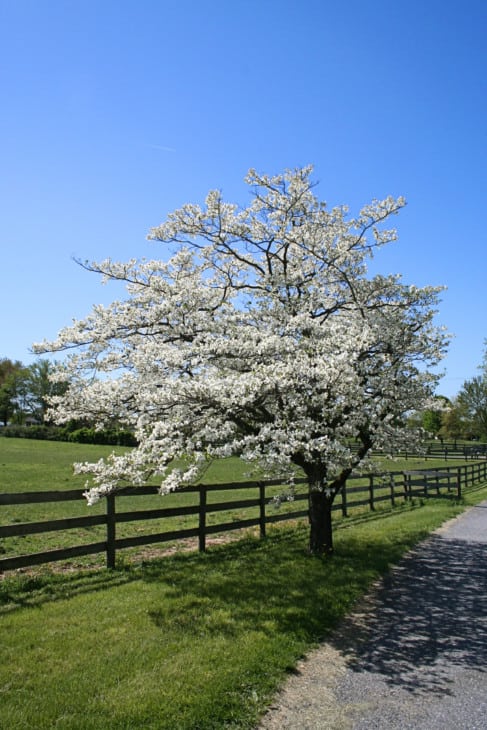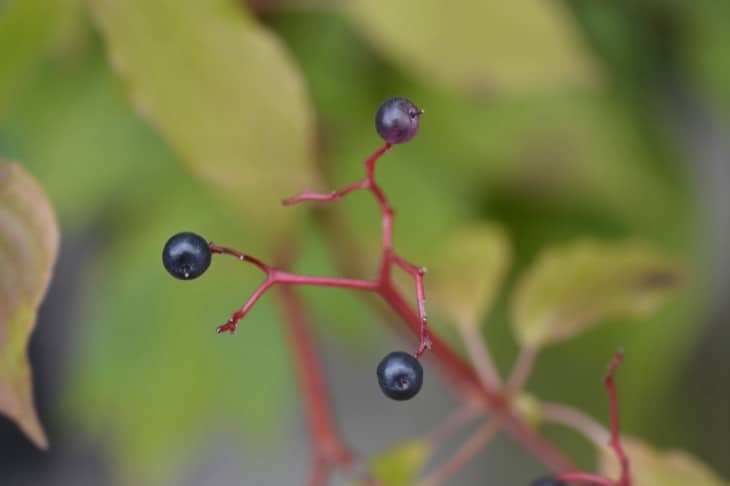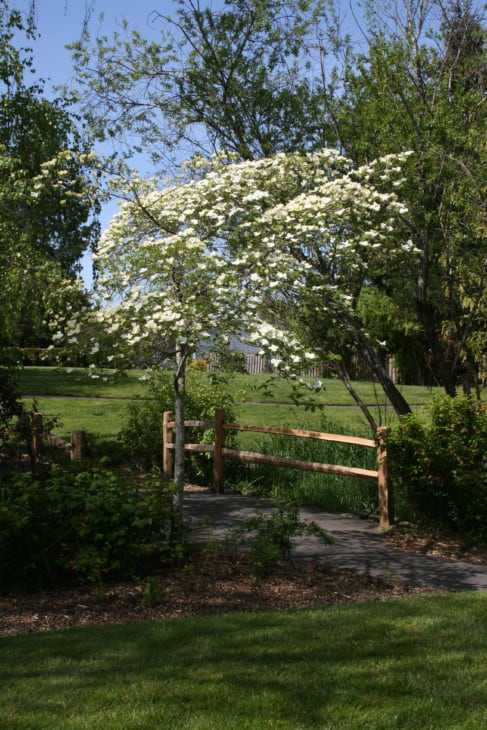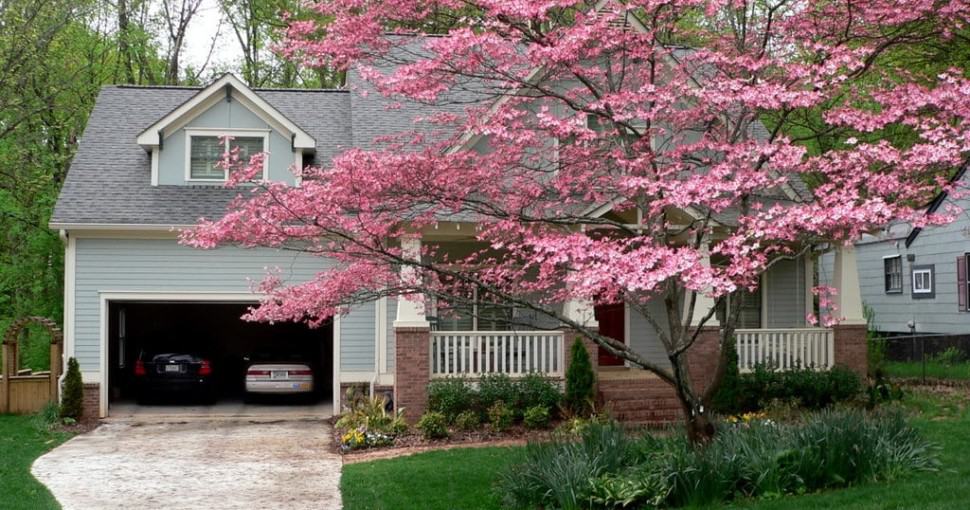Dogwoods (Cornus spp.) are super popular ornamental trees that are native to the US. Horticulturalists have selectively bred them for a long time, so there are many different cultivars to choose from. Landscapers love dogwood trees for several reasons, but unfortunately, they also have some negative traits.
Pros:
- Dogwood trees flower beautifully in spring with white or pink blossoms.
- Flowering dogwoods attract many insect pollinators to the garden.
- If you want an ornamental tree that looks great all year round, choose a dogwood.
- Dogwood trees are easy to grow from seed that you have collected.
- Dogwood trees can easily be propagated from cuttings.
- You can grow a dogwood tree in a container.
- Dogwoods’ compact size makes them perfect for small gardens.
- They do not need much maintenance in terms of pruning or training.
Cons:
- The blossoms of a dogwood tree are poisonous.
- Dogwood trees give off a very strong, distinctive odor that not all people are fond of.
- Dogwood trees struggle to flower if they do not get enough water and sunlight or too much fertilizer.
- Dogwood trees are difficult to transplant and often do not transplant well.
- They do not get very old, living for 10 to 15 years at most.
- Dogwood trees drip sap when they are stressed.
Pros Of Dogwood Trees
There is a reason that dogwoods are such popular trees among gardeners. They have so many great characteristics.
Here, we look at some of the benefits of growing a dogwood tree in your garden:
Dogwood Trees Flower Magnificently
Around mid-spring, before they have grown any leaves, dogwood trees burst into color. They flower profusely and closely resemble Japanese cherry blossoms.

Dogwood flowers are tiny and range from white to light pink and even red in some cultivars. The flowers last for about two weeks, so you get plenty of time to enjoy their beauty.
Flowering Dogwoods Attract Pollinators
Dogwood trees rely on insects for pollination. Their flowers produce loads of nectar to attract pollinators such as bees and butterflies.
Not only are dogwood trees beneficial to important insects, like bees, but they benefit us by attracting wildlife to our gardens. More insects in your garden means that more birds will visit. This is wonderful if you enjoy bird watching.

Dogwood trees’ flowers turn into beautiful red berries, or drupes, in late fall. These will attract even more wildlife to your garden. Squirrels, rabbits, skunks, deer, and over 75 bird species feed on dogwood drupes.
Dogwoods Look Fantastic All Year Round
There is never a dull moment for dogwood trees. They put on a magnificent display for every season.
In summer, they are covered with glossy green leaves, which turn purple-red in the fall. Fall is also the time dogwoods produce their little crimson berries.
During the winter, dogwoods lose their leaves, so you can marvel at the scale-like bark and the beautifully tiered branches. In spring, they are covered in white, pink, or red flowers – truly a sight to behold.
Dogwoods Are Easy To Propagate From Seed Or Cuttings
Few things are as rewarding as growing your very own tree from seed. Dogwood trees are very easy to cultivate, even for inexperienced gardeners.
Dogwoods also propagate readily from cuttings. You can create as many trees as your heart desires practically for free.
Dogwoods Are Small Trees That Do Not Need Lots Of Space
You can grow a dogwood tree in the smallest of gardens. Dogwoods can even be grown in a large pot. These compact trees only grow to about 15-20 feet in height.

Because dogwoods have a relatively small canopy and rootstock, they can be planted close to the walls of your house. There is no risk of the roots damaging paving or the foundation of your house!
Dogwoods Are Low Maintenance Trees
You will not have to spend much time pruning dogwood trees or training them to grow the way you want. Dogwoods require little maintenance, helping to keep your to-do list in the garden short.
Larger trees in urban areas often need to be pruned because they grow too close to power lines. You will not have this issue with a dogwood tree.
The only thing you need to do is remove old, dead branches and apply some mulch around the base of the dogwood tree in the fall.
Cons Of Dogwood Trees
Despite all their charms, there are still some drawbacks to growing a dogwood tree in your garden. Let’s look at some of their negative traits that one should consider before planting a dogwood near your house.
Related: 6 Dogwood alternatives
Dogwood Flowers And Fruits Are Poisonous To Humans
Even though dogwood berries look delicious, they are toxic to humans. If you have children, this is something to be aware of especially. Luckily the berries taste extremely bitter, so they are not particularly enticing.
People have reported developing a rash after coming into contact with dogwood flowers. While they are not super toxic, there is a risk of skin irritation. It may be better to admire them from a distance while they are in bloom.
Related: Are Dogwood Berries Poisonous?
Dogwood Trees Can Be Smelly
Dogwoods have a very distinctive odor. Not everyone finds it unpleasant, but some people say that it smells fishy – perhaps not a smell you would want wafting through your window.
It is a good idea to visit a park with a flowering dogwood to see what you think of the smell before buying one. If you find it unbearable, then you will know to look for another type of small tree.
Without Enough Water And Sunlight Dogwoods Do Not Flower
Dogwoods can be quite finicky when it comes to flowering. They need the right light and soil conditions to put on a spectacular spring display. Dogwoods are quite heavy drinkers. They need to be well watered to ensure they flower well.
Plant your dogwood in a place where it will get about 4 hours of direct sunlight every day. Too much more or less than this, and the tree may not flower.
If there is too much nitrogen in the soil, dogwoods will not flower. Instead, they put all their energy into growing leaves and branches. Be sure not to fertilize a dogwood tree too often, if at all.
Dogwood Trees Are Difficult To Transplant
When you buy a dogwood tree for your garden, think very carefully about where you plant it. Once planted, they are very difficult to transplant.
Dogwoods often develop root rot if they are transplanted while their sap is still flowing. If you absolutely must, move your dogwood tree during the winter while it is dormant.
Dogwoods Are Short-Lived
Dogwood is not the type of tree you grow for your great-grandchildren to play under. Dogwoods have a relatively short lifespan. They usually die after about 10 to 15 years.
Keep this in mind when you are using dogwood trees in your landscape. If you want to enjoy them for as long as possible, it may be better to grow them from seed or cuttings rather than buying a larger tree that is already a few years old.
Dogwood Trees Can Drip Sap
When dogwood trees are stressed, they exude a sticky, see-through liquid. If it drips onto your car or outdoor furniture in the shade of the tree, it can be very annoying. Old dogwoods are especially prone to dripping sap.
Various things cause dogwood trees to drip sap – too little soil nutrients, pest infestations, damage during a storm, or pruning at the wrong time of year.







